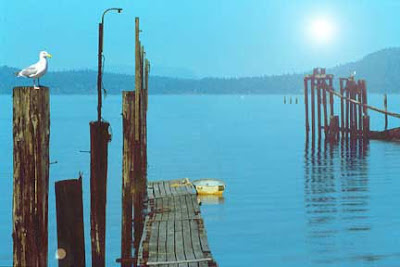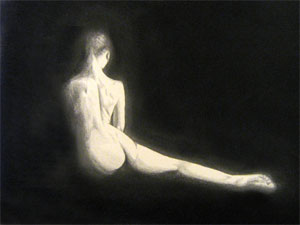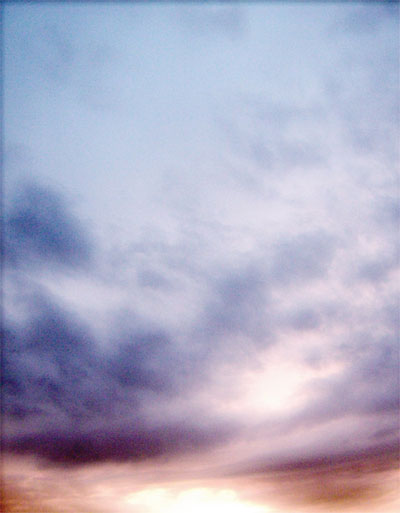One © 2010 Manuel Erickson
I've been thinking more about my father lately. I just finished reading a couple of self-published stories with a Scottish tang to them; I would like to visit Scotland and see Old Cumnoch, the village where Dad was born, and I find myself wondering if I shall.
Sometimes I hear a voice in my head—my mother?—an aunt?—a cousin?—saying that I look like my father, that my personality is a lot like his, that I sound like him. Apart from his hot temper (which I have inherited) and his jealousies (which I have not), I don’t mind. Dad was a liberal thinker; so am I. He voted for the Left Wing; so do I. He loved Beethoven, "the man who freed music"; so do I.
At least, I love Beethoven now, though I didn't, or tried not to, when I was a boy. At that time, I didn't want to be like my dad; I didn't want to be an upholsterer like him, nor did I want his bad temper or his jealous nature. Since he liked Beethoven's music, I tried not to like it.

Dad, Age About 77
photo of Harry Erickson |
A free thinker, Beethoven had originally dedicated his Eroica Symphony to Napoleon, but when Napoleon declared himself emperor, Beethoven tore the dedication page from the manuscript, an action Dad and I supported. We were also free thinkers.
When I was young, I rebelled against anything Dad liked so I would resemble him less. Now, I want to rebel against my physical infirmities, especially the ringing in my ears, the tendonitis in my right elbow that keeps me from playing the piano as much as I want, and the elbow brace I must wear for support when I type.
I'm angry with myself for allowing my own pianistic skills to deteriorate as they have. I remember the letter that the Royal Conservatory's principal, David Ouchterlony, mailed to my piano teacher when I was only fifteen, in which he said I could be "a first-rate concert pianist." I wanted to be a baseball player, not a pianist.
I'm deeply disappointed, as well, that my compositional abilities never amounted to much, though I hear new melodies in my head from waking to sleeping and all the hours in between.
One morning I dreamed about my father. I watched and listened to him play the piano. It was a dark brown upright; he sat on an equally dark, round, adjustable wooden stool. He had placed his left leg askew from his body while his other foot worked the forté pedal, putting his entire body at an angle to the keyboard—a relaxed professional.
He played something by Chopin. I didn't recognize the piece, but it was fast and melodious. His fingers seemed to glide over the keys, and his face had the happy look of a person who enjoyed tossing off works of art. He barely looked at his hands, and as he played, he turned and flashed a delightful smile at me.
I was astonished at this scene. How is it I didn't know Dad could play? And how does he manage to get his thick fingers between the black keys? How can he play at all with his swollen knuckles developed from years of doing upholstery? When did he have the time to learn? For goodness’ sake—what mastery he has!
The dream felt real, as real as sitting at the computer, typing this story. But it was only a dream.
Did Dad ever play the piano? Not to my knowledge. I don't remember that he even plinked a key, let alone played Chopin.
I dreamed about my father because I loved him. I loved his fairness, profound sense of justice and his tenacity, all of which I have inherited. It's sad that I didn't realize it until years later.
TwoPerhaps it's a result of reading over fifty-year-old letters: I dreamed again about my father last night.
I was upstairs in our Toronto house on Lauder Avenue when Dad slowly trudged up the steps. "Hello, Dad!" I said brightly. "How are you?"
He looked at me, his face drawn. Then he turned to the wall and gently placed his forehead against it. "I'm just so very tired," he said.
I woke up then. Martha was already awake.
"I had a strange dream about my father."
She waited, but I said nothing. "Well, are you going to tell me?"
I related the dream. I felt a certain stuffiness inside my head, somewhere behind my eyes, and tears flowed freely down my cheeks and onto the pillow.
Martha held me for a while, then got up. "That's not a 'strange' dream; it's a sad one."
"Maybe it's because of the old letters I've been reading," I said.
"That's probably the reason."
The year of my dream must have been 1957. Dad sold his business the following year, and Mom reported in a letter to me that Dad had changed for the better: he felt good about himself once again.
© 2010 Manuel Erickson
















 When Cally's own imagination and adventures take her into fearful places, she can find refuge in her mother's garden: it is fenced and has a gate to keep out the wild things.
When Cally's own imagination and adventures take her into fearful places, she can find refuge in her mother's garden: it is fenced and has a gate to keep out the wild things.







 Painting allows me to simply enjoy the process of painting as itself. My days are very full right now, so at night I can relax, pick up a brush, and enjoy the fluidity that emerges. Recent paintings reflect this idea of movement and flow, usually interrupted with spots of concise forms. I use colors that tend to be calming or warm, with flashes of energy here and there to add some fun. Because, ultimately, my art does reflect my life.
Painting allows me to simply enjoy the process of painting as itself. My days are very full right now, so at night I can relax, pick up a brush, and enjoy the fluidity that emerges. Recent paintings reflect this idea of movement and flow, usually interrupted with spots of concise forms. I use colors that tend to be calming or warm, with flashes of energy here and there to add some fun. Because, ultimately, my art does reflect my life.


 It is the feeling I get when I am in a place that makes me want to paint. This emotional response is what starts me on a painting and is what I want to interpret. As a result, I often stray far from the original idea, the painting takes over, colours, shapes and rhythms assert themselves. I love to play, experiment and change things and so my paintings do not always follow the same rules. I allow myself this freedom, and yet in the end certain aspects of my style seem to come through—I don’t really know how.
It is the feeling I get when I am in a place that makes me want to paint. This emotional response is what starts me on a painting and is what I want to interpret. As a result, I often stray far from the original idea, the painting takes over, colours, shapes and rhythms assert themselves. I love to play, experiment and change things and so my paintings do not always follow the same rules. I allow myself this freedom, and yet in the end certain aspects of my style seem to come through—I don’t really know how. Born in Vancouver, Peter Spohn received his formal art education at the Banff Center of Fine Arts and at U.B.C. Later he received a B.F.A. with honours from Haverford College, Pa. and an in 1976 a M.F.A. from the Pratt Institute in Brooklyn, N.Y. He spent twelve years studying and teaching art in New York and Pennsylvania where he could be close to the great art museums and fully absorb the tradition of western painting.
Born in Vancouver, Peter Spohn received his formal art education at the Banff Center of Fine Arts and at U.B.C. Later he received a B.F.A. with honours from Haverford College, Pa. and an in 1976 a M.F.A. from the Pratt Institute in Brooklyn, N.Y. He spent twelve years studying and teaching art in New York and Pennsylvania where he could be close to the great art museums and fully absorb the tradition of western painting.



